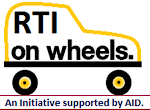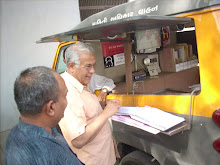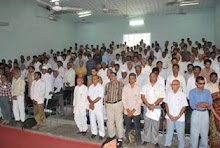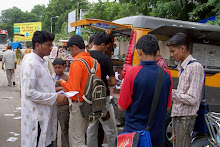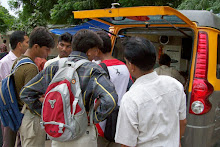Tehelka Magazine, Vol 7, Issue 40, Dated October 09, 2010;
Three RTI activists were murdered in this country in three months — Datta Patil on 26 May, Amit Jethwa on 20 July and Ramdas Ghadegaonkar on 27 August. Besides, TEHELKA has tracked many more who are living in fear of their lives. Here we tell heartbreaking stories of petitioners who have been harassed for having the temerity to use this Act. This is not the kind of stock-taking that a democracy should be doing to mark five years of the RTI Act 2005.
Amit Jethwa, a 32 year old RTI activist from Gir, was shot dead by two assailants on a motorbike outside the Ahmedabad High Court on the 20th of July. Less than a month ago Jethwa had used information obtained under the Right To Information Act 2005 to expose the network of illegal mining run by BJP MP Dinu Solanki in the Gir forest area. On the 7th of September, the MP’s nephew Shiva Solanki was arrested for Jethwa’s murder.
The horror of this story is a small part of the sweeping phenomenon of intimidation, harassment and murder of RTI petitioners throughout the country. 9 RTI activists have been killed this year.
But murder is usually the last step in a build up of harassment that takes many forms. Invention of cases and imprisonment is the most common form of police harassment, but it is not unlikely for the force to physically assault petitioners either.
In other cases, intimidation is dealt out via less ‘legitimate’ channels. From Jharkhand, Sumit Kumar Mahato, Convenor of the RTI Forum, talks about being manhandled by goons for seeking information about funds spent on the building of a road. Rolly Shivhare of Jaano Re Abhiyaan from MP says, “I filed an application to ask for the Midday Meal Scheme budget from the Panchayat and Rural Welfare Department. I received a threatening phone call asking what I would do with this information. The caller said he was the ‘Development Commissioner’. When the police traced the call, it was found that it had indeed come from his office, though the commissioner himself denied any knowledge of it.”
RTI activists have learnt through unfortunate examples not to take such initial threats lightly. Down south in Karnataka, Venkatesh, 32, had filed an application to expose the Bangalore Development Authorities’ involvement in a land scam case. Despite receiving threats, he continued to pursue the case alone. In April 2009, Venkatesh’s body was found near the divider of a highway. His death was registered as a traffic accident. The RTI Study Centre filed an RTI application for the post-mortem report which revealed that his head injury was caused by a blunt instrument. On investigation, four people were charged. They have all been linked to the contractors involved in the scam.
Malay Bhattacharya, secretary of the West Bengal RTI Manch differentiates between the harassment in urban and rural areas, “In urban West Bengal, applicants are harassed by the police who come to their house and threaten them and their family members.” In villages, he says, the authorities ensure that those filing RTI applications are boycotted socially.
Patterns differ from state to state but every state can be mapped with such stories, each one more horrific than the other. From tiny tribal villages to the bustling lanes of Mumbai and Delhi; from farmers and lorry drivers to middle class professionals- cases of criminal harassment following RTI applications abound everywhere. The monitory and emotional fallouts in all cases are life altering for the petitioners and their families.
In most cases, the petitioners that are attacked have already been through harassment, because of rigorous attempts to obstruct their application. Almost always the information is refused at first. Harinesh Pandya, founder of Mahiti Adhikar Gujarat Pahel says, “Under s.4 of the Act, all departments must pro-actively make mandatory disclosures. But they routinely fail to do so. From over 55,000 calls received on our helpline, nearly 80% relate to information that is already covered under S. 4.”
It is common practice for officials to say the information one is asking for endangers ‘national security’ or is ‘secret’. “We were denied basic information like the names of people booked under the UAPA and the number of Special Police Officers in Orissa,” says Sharanya Nayak, from Action Aid, Orissa. In almost every state rules that go against either the spirit or the letter of the Act impede its affectivity (effectivity? check this). For instance, Chittaranjan Behera, freelance consultant on governance issues, informs us that the Orissa government’s rules relating to payment required to access information make it extremely difficult for villagers to avail of their rights. Similarly, activist Izhar Ansari tells us, “In UP the summons for the appeal hearings are sent by plain post by the State Information Commission – not even registered or speed post.” So often those summoned claim not to have received it to get away.
What is most dangerous is that in many instances the RTI application form requires the applicant to provide their permanent address, photo identification and father/spouse names .The availability of these details makes the applicant vulnerable to attacks.
So what needs to be done to reinstate the spirit of the Act? Clearly, there’s a need to re-assess the rules for filing applications made by each state under the Act and ensure that they do not undermine its intent.
Secondly, it is imperative that all departments covered by the Act are made to follow S. 4 and make mandatory disclosures pro-actively. This will reduce the burden of numbers of applications and protect applicants against the risk of having to ask for it personally. To begin with the Commissions can allocate a PIO from within each department who takes on the responsibility of disclosure. In addition, providing monetary compensation to applicants who have to file for information that must be in the public domain will act as a deterrent for the errant departments.
Thirdly, a central advisory body, similar to the one set up to supervise NREGA, must be constituted. This council, comprising all stakeholders, can act as mediator between the users of the Act and the government. Its principal role will be to monitor problems of implementation and complaints of harassment and make recommendations on these bases.
The fourth issue which needs to be addressed is grievance redressal. RTI applications throw up three kinds of issues- related to monetary corruption, improper governance or misuse of power. Once you have the information you seek, it can only be useful if it allows you to take action against wrongdoers. The existing investigative agencies are either toothless or biased. For instance, in most states the Anti Corruption Bureau directs a complaint back to the department against which it is filed for rectification. The police, on the other hand, when not directly the subject of the complaint, are almost always in cohorts with the politician-bureaucrat-businessman nexus implicated. Setting up Ombudsman bodies – Lokayuktas – can fill in this vacuum if they are empowered to act strongly and the public plays a role in electing the members. These Lokayuktas will investigate charges of corruption against different organs of the government. Similarly a properly enabled and constituted nationwide Public Grievances Commission can take up issues of mis-governance where these organs are not functioning properly.
Finally, people’s movements should take up the harassment of RTI activists in one of two ways- whenever harassment is reported in a case, several applications by different persons or organizations must be filed for the information being sought by the harassed person. It is always more difficult to silence a collective voice. In the unfortunate instance of an RTI activist being murdered or tortured, civil society groups should focus their attention and ensure the information the individual was seeking is brought out. This will act as a deterrent to those responsible for such crimes.
However, no legislative reform is complete without a reform of the executive that implements it. This reform too must begin within the Commissions themselves. A source, who does not wish to be named, reveals that in UP all Information Commissioners are political appointees. “Four out of eleven are affiliated to the BSP, seen in every major rally,” says this source. “And the rest are from the Samajwadi Party, who will be replaced by candidates from the ruling party as soon as their term runs out.” This is a nation wide trend. In Haryana, Subhash, Editor of India Post – an RTI newsletter that is published fortnightly from Rohtak filed applications that revealed shocking corruption within the State Information Commission.
At the root of this is the lack of transparency in the selection procedure. Centrally, the PM along with a cabinet minister nominated by him and the leader of opposition choose the Commissioners. At the state level the selection is carried out by the CM, one of his ministers and the opposition leader of the Legislative assembly. In principle the Act envisages people from all walks of life in the Commission – allotting a greater role to civil society. However in practice the commission is seen as an extension of the civil services, populated almost entirely by retired bureaucrats who are so entrenched in the system, it is impossible for them to act against their own colleagues. To repair this, posts in the commissions must be reserved for members of civil society who do not have a background in government service.
All of these changes can and should be brought about without amending the Act, because over the last couple of years the government has proposed several amendments that will water down its effect. There is a fear that opening up the Act to improve it might make it vulnerable to more regressive changes as well.
Besides, the drafting of the Act to a great extent is competent in itself. The larger problem lies with its implementation that requires political will. And given that the Act is under the supervision of the Ministry of Personnel, Public Grievances and Pensions, a portfolio held by the PM himself, the culpability for its failure goes to the very top.
This backlash against petitioners is proof of the potency of the RTI. But what is it that is making thousands of ordinary citizens—who have hardly ever used laws without the interface of lawyers and law-keepers-- risk life and liberty for this Act? India fought long and hard for democracy in a movement that has informed the imagination of every generation since. Today its very idea is endangered for an electorate that has limited choices when it comes to choosing leaders. This Act provides an opportunity for every single citizen to participate in the governance of the country by asking questions about decisions made by the state. And when citizens set out to reclaim their right to govern, there is bound to be a struggle for the inversion of power. Many activists see this as the new fight for freedom. But Right to Life is more fundamental to freedom. And without it, Right to Information cannot fulfill its revolutionary potential.




